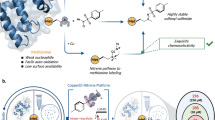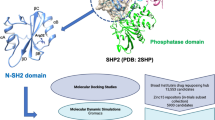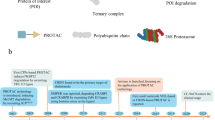Abstract
Many serine proteases are targets for therapeutic intervention because they often play key roles in disease1. Small molecule inhibitors of serine proteases with high affinity are especially interesting as they could be used as scaffolds from which to develop drugs selective for protease targets. One such inhibitor is bis(5-amidino-2-benzimidazolyl)methane (BABIM), standing out as the best inhibitor of trypsin (by a factor of over 100) in a series of over 60 relatively closely related analogues2,3,4. By probing the structural basis of inhibition, we discovered, using crystallographic methods, a new mode of high-affinity binding in which a Zn2+ ion is tetrahedrally coordinated between two chelating nitrogens of BABIM and two active site residues, His 57 and Ser 195. Zn2+, at subphysiological levels, enhances inhibition by over 103-fold. The distinct Zn2+ coordination geometry implies a strong dependence of affinity on substituents. This unique structural paradigm has enabled development of potent, highly selective, Zn2+-dependent inhibitors of several therapeutically important serine proteases, using a physiologically ubiquitous metal ion.



Similar content being viewed by others
References
Stroud, R. M. Afamily of protein-cutting proteins. Sci. Am. 231, 74–88 (1974).
Tidwell, R. R. & Geratz, J. D. Diarylamidine derivatives with one or both of the aryl moieties consisting of an indole or indole-like ring. Inhibitors of arginine-specific esteroproteinases. J. Med. Chem. 21, 613–623 (1978).
Jennette, J. C., Tidwell, R. R., Geratz, J. D., Bing, D. H. & Falk, R. J. Amelioration of immune complex-mediated glomerulonephritis by synthetic protease inhibitors. Am. J. Pathol. 127, 499–506 (1987).
Caughey, G. H., Raymond, W. W., Bacci, E., Lombardy, R. J. & Tidwell, R. R. Bis(5-amidino-2-benzimidazolyl)methane and related amidines are potent, reversible inhibitors of mast cell tryptases. J. Pharmacol. Exp. Ther. 264, 676–682 (1993).
Lipscomb, W. N. & Sträter, N. Recent advances in zinc enzymology. Chem. Rev. 96, 2375–2433 (1996).
Christianson, D. W. Structural biology of zinc. Adv. Protein Chem. 42, 281–355 (1991).
Kimura, E., Shiota, T., Koike, T., Shiro, M. & Kodama, M. Azinc(II) complex of 1,5,9-triazacylcododecane ([12]aneN3) as a model for carbonic anhydrase. J. Am. Chem. Soc. 112, 5805–5811 (1990).
Groves, J. T. & Olson, J. R. Models of zinc-containing proteases. Rapid amide hydrolysis by an unusually acidic Zn+2-OH2complex. Inorg. Chem. 24, 2715–2717 (1985).
Vedani, A. & Huhta, D. Anew force field for modeling metalloproteins. J. Am. Chem. Soc. 112, 4759–4767 (1990).
Krieger, M., Kay, L. M. & Stroud, R. M. The structure and specific binding of trypsin: A comparison of inhibited derivatives and a model for substrate binding. J. Mol. Biol. 83, 209–230 (1974).
Katz, B. A., Finer-Moore, J. S., Mortezaei, R., Rich, D. H. & Stroud, R. M. Novel Ki∼ nanomolar inhibitors of serine proteases by binding or epitaxial chemistry on an enzyme surface. Biochemistry 34, 8264–8280 (1995).
Ippolito, J. A., Alexander, R. S. & Christianson, D. W. Hydrogen bond stereochemistry in protein structure and function. J. Mol. Biol. 215, 457–471 (1990).
Perona, J. J. & Craik, C. S. Structural basis of substrate specificity in the serine proteases. Protein Sci. 4, 337–360 (1995).
Tidwell, R. R., Geratz, J. D., Clyde, W. A., Rosenthal, K. U. & Dubovi, E. J. Suppression of respiratory syncytial virus infection in cotton rats by bis(5-amidino-2-benzimidazolyl)methane. Antimicrob. Agents Chemother. 26, 591–593 (1984).
Lenter, C. (ed.) Geigy Scientific Tables Vol. 3 Physical Chemistry Composition of Blood Hematology Somatometric Data 87 (Ciba-Geigy, Basle, Switzerland, 1984).
Hambridge, K. M., Casey, C. E. & Krebs, N. F. in Trace Elements in Human and Animal Nutrition 5th edn vol. 2(ed. Mertz, W.) 15 (Academic, Orlando, Florida, 1996).
Lippard, S. J. in Bioinorganic Chemistry (eds Bertini, I., Gray, H. B., Lippard, S. J. & Valentine, J. S.) 505–583 (University Science, Mill Valley, CA, 1994).
Berners-Price, S. J. & Sadler, P. J. Coordination chemistry of metallodrugs: insights into biological speciation from NMR spectroscopy. Coord. Chem. Rev. 151, 1–40 (1996).
Tong, L. et al. Anew serine-protease fold revealed by the crystal structure of human cytomegalovirus protease. Nature 383, 272–275 (1996).
Matthews, D. J. & Wells, J. A. Engineering an interfacial zinc site to increase hormone-receptor affinity. Chem. Biol. 1, 25–30 (1994).
Somers, W., Ultsch, M., De Vos, A. M. & Kossiakoff, A. A. The X-ray structure of a growth hormone-prolactin receptor complex. Nature 372, 478–481 (1994).
Brinen, L. S., Willett, W. S., Craik, C. S. & Fletterick, R. J. X-ray structures of a designed binding site in trypsin show metal-dependent geometry. Biochemistry 35, 5999–6009 (1996).
Tidwell, R. R., Geratz, J. D. & Dubovi, E. J. Aromatic amidines: comparison of their ability to block respiratory syncytial virus induced fusion and to inhibit plasmin, urokinase, thrombin, and trypsin. J. Med. Chem. 26, 294–298 (1983).
McGrath, M. E. et al. Production of crystallizable human chymase from a Bacillus subtilis system. FEBS Lett. 413, 486–488 (1997).
Tanaka, R. D., Clark, J. M., Warne, R. L., Abraham, W. M. & Moore, W. R. Mast cell tryptase: a new target for therapeutic intervention in asthma. Int. Arch. Allergy Immunol. 107, 408–409 (1995).
Kuzmic, P. Program DYNAFIT for the analysis of enzyme kinetic data: application to HIV proteinase. Anal. Biochem. 237, 260–273 (1996).
Katz, B. A. & Cass, R. T. In crystals of complexes of streptavidin with peptide ligands containing the HPQ sequence the pKaof the peptide histidine is less than 3.0. J. Biol. Chem. 272, 13220–13228 (1997).
Kabsch, W. Evaluation of single-crystal X-ray diffraction data from a position-sensitive detector. J. Appl. Crystallogr. 21, 916–924 (1988).
Brünger, A. T. in X-PLOR Manual, version 3.1: A System for X-ray Crystallography and NMR 187–206 (Yale University, New Haven, CT, 1990).
Brünger, A. T. The free R value: a novel statistical quantity for assessing the accuracy of crystal structures. Nature 355, 472–474 (1992).
Acknowledgements
We thank K. Spear for synthesis of BABIM, T. Church and M. Linsell for synthesis of Arris compounds, L. Cregar, D. Putnam and R. Warne for enzyme assays, and M. Venuti for review and discussion of the manuscript.
Author information
Authors and Affiliations
Corresponding author
Additional information
Brookhaven Databank accession codes are given in Table 2.
Rights and permissions
About this article
Cite this article
Katz, B., Clark, J., Finer-Moore, J. et al. Design of potent selective zinc-mediated serine protease inhibitors. Nature 391, 608–612 (1998). https://doi.org/10.1038/35422
Received:
Accepted:
Issue Date:
DOI: https://doi.org/10.1038/35422
- Springer Nature Limited
This article is cited by
-
Oral Delivery of Peptide Formulations and Their Cellular Evaluation
International Journal of Peptide Research and Therapeutics (2021)
-
A novel FRET peptide assay reveals efficient Helicobacter pylori HtrA inhibition through zinc and copper binding
Scientific Reports (2020)
-
Inhibitory zinc sites in enzymes
BioMetals (2013)





